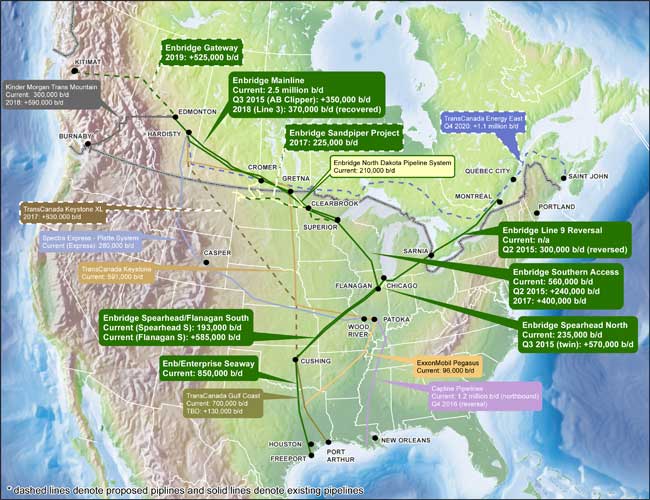Market Snapshot: Enbridge’s Market Access Programs Part I: Enbridge Completes $10 Billion in Projects in 2014
Release date: 2015-04-14
By early 2015, price discounts on Canadian oil had stabilized at the lowest levels in years. The lower discounts have been the result of lower oil prices overall and additional pipeline capacity that has increased market access for Canadian producers. Enbridge has played a large part in reconnecting land-locked crude oil sources with seaborne markets. In 2014, Enbridge placed 15 projects into service at a combined cost of $10 billion. Through efficiencies achieved on the Canadian Mainline, Enbridge was able to increase its shipments across the U.S. border to over 2.06 million barrels per day in Q4-2014, up from an average of 1.7 million barrels per day in 2013.
The map below shows major existing and proposed oil pipelines in North America, with the facilities that Enbridge owns or has an interest in identified with green fill or borders.
Enbridge’s Pipelines and Projects Among Other Major North American Oil Pipelines
Figure Sources and Description
Sources: CAPP, company websites, NEB. Note: In-service dates are the companies’ expectations.
Description: The map above shows major oil pipelines and pipeline proposals in Canada and the U.S. The map is focused on pipelines that ship Canadian oil, and in particular, the pipeline systems that Enbridge owns. Each text box shows the names of the pipelines, the nominal capacity of the systems, and the companies’ target in-service dates for proposed pipelines.
Details on a few of the projects that Enbridge completed in 2014 which assist in moving Canadian crude to markets are provided below.
- Enbridge received Board approval to expand Line 67 (Alberta Clipper) [Filing A50564] in February 2013. Enbridge effectively completed the necessary facility construction for the initial phase (+120 thousand barrels per day) in the third quarter of 2014. While it pursues approval from the U.S. Department of State for an amendment to the Alberta Clipper Presidential Permit, the company is implementing “temporary system optimizations”, allowing additional volumes to flow on the Alberta Clipper by utilizing parts of Line 3 near the international border that are not pressure restricted. Similar to the first phase, the second phase (230 thousand barrels per day) would involve adding pump and meter stations but no new pipe.
- For several years, a lack of sufficient capacity flowing southeast of Superior, WI, was a bottleneck on Enbridge’s system. Enbridge’s primary solution to this is the “Southern Access” project, an expansion of Line 61 which stretches from Superior to Flanagan, IL. Similar to the Clipper expansion, Southern Access has two phases that require additional pumping horsepower with no new pipeline construction. The initial phase to increase the capacity from 400 thousand barrels per day to 560 thousand barrels per day was completed in August 2014.
- In 2014, the “Gulf Coast Access” program was significantly advanced with the completion of the 600 thousand barrels per day Flanagan South Pipeline (Q4-2014) and 450 thousand barrels per day Seaway Pipeline loop (December 2014). With these two lines in place, Enbridge can now move up to 600 thousand barrels per day of Canadian crude onward from Flanagan to either Cushing or the U.S. Gulf Coast.
- The replacement of Line 6B (which ruptured near the Kalamazoo River in 2010) was completed in September 2014. This, along with the reversal of Line 9, is part of Enbridge’s “Eastern Access” program.
- Date modified:

